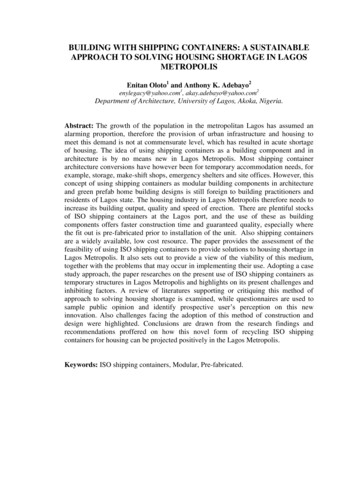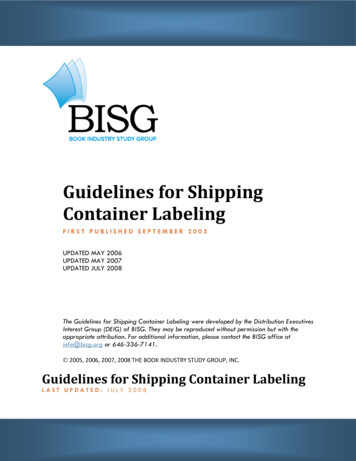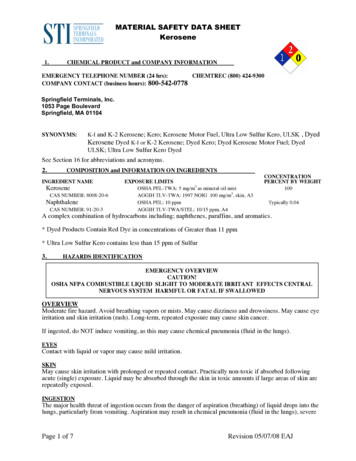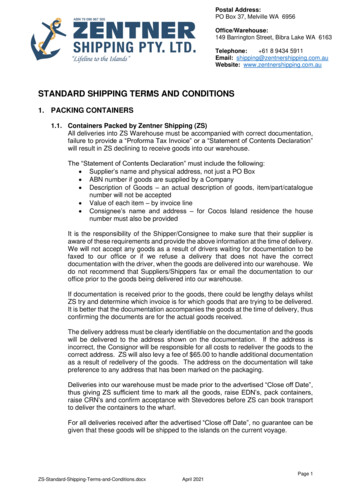
Transcription
BUILDING WITH SHIPPING CONTAINERS: A SUSTAINABLEAPPROACH TO SOLVING HOUSING SHORTAGE IN LAGOSMETROPOLISEnitan Oloto1 and Anthony K. Adebayo2enylegacy@yahoo.com1, akay.adebayo@yahoo.com2Department of Architecture, University of Lagos, Akoka, Nigeria.Abstract: The growth of the population in the metropolitan Lagos has assumed analarming proportion, therefore the provision of urban infrastructure and housing tomeet this demand is not at commensurate level, which has resulted in acute shortageof housing. The idea of using shipping containers as a building component and inarchitecture is by no means new in Lagos Metropolis. Most shipping containerarchitecture conversions have however been for temporary accommodation needs, forexample, storage, make-shift shops, emergency shelters and site offices. However, thisconcept of using shipping containers as modular building components in architectureand green prefab home building designs is still foreign to building practitioners andresidents of Lagos state. The housing industry in Lagos Metropolis therefore needs toincrease its building output, quality and speed of erection. There are plentiful stocksof ISO shipping containers at the Lagos port, and the use of these as buildingcomponents offers faster construction time and guaranteed quality, especially wherethe fit out is pre-fabricated prior to installation of the unit. Also shipping containersare a widely available, low cost resource. The paper provides the assessment of thefeasibility of using ISO shipping containers to provide solutions to housing shortage inLagos Metropolis. It also sets out to provide a view of the viability of this medium,together with the problems that may occur in implementing their use. Adopting a casestudy approach, the paper researches on the present use of ISO shipping containers astemporary structures in Lagos Metropolis and highlights on its present challenges andinhibiting factors. A review of literatures supporting or critiquing this method ofapproach to solving housing shortage is examined, while questionnaires are used tosample public opinion and identify prospective user’s perception on this newinnovation. Also challenges facing the adoption of this method of construction anddesign were highlighted. Conclusions are drawn from the research findings andrecommendations proffered on how this novel form of recycling ISO shippingcontainers for housing can be projected positively in the Lagos Metropolis.Keywords: ISO shipping containers, Modular, Pre-fabricated.
INTRODUCTIONWhile the growth of the population in the metropolitan Lagos has assumed ageometrical proportion, the provision of urban infrastructure and housing to meet thisdemand is, not at commensurate level. This has resulted in acute shortage of housingto the teeming population with Lagos alone accounting for about 5 million deficitrepresenting 31% of the estimated national housing deficit of 18 million (Oshodi,2010). The extent of the housing shortage in Lagos is enormous. The inadequacies arefar-reaching and the deficit is both quantitative and qualitative; even those householdswith shelter are often subjected to inhabiting woefully deficient structures asdemonstrated in the multiplication of slums from 42 in 1985 to over 100 as at January2010 (Igbinoba 2009). The problem of providing qualitative housing has been aconcern for both the government and many individuals. Appreciating these problems,both the government (Public developers) and these individuals (Private developers)through their various activities strive to balance the gap in housing supply anddemand, but the cost of building materials, stringent loan conditions from mortgagebanks, government policies amongst other problems have been affecting housingdelivery (Ademiluyi and Raji, 2008). One major problem of housing delivery is theissue of cost of building materials, this and other factors like cost of land acquisitionhave been the major setbacks in providing affordable homes for the urban populace inLagos state, of which 60% of residents are tenants and have to pay rent as high as 5070% of their monthly incomes since most of the existing accommodations areprovided by private landlords. It is against this backdrop that the paper seeks to look atan alternative approach and method of construction through which both public andprivate developers can provide sustainable housing in Lagos metropolis. The paperfocuses on the use of ISO shipping containers as alternatives for solving acute housingshortage in Lagos. Growing popularity and pressure for sustainable developmentacross the globe has gradually increased the interest of architects, builders, developersand end-users all over Europe and America in cargo container structures for greenhousing alternatives. This is because it’s too expensive for a country to ship emptycontainers back to their origin and therefore much cheaper to buy new containers fromAsia. The outcome of this situation is an extremely congestion of ports globally withempty shipping containers that are just waiting to become a home, office, apartment,school, dormitory, studio, emergency shelter, and everything else etc. This is alsowitnessed in the West African coasts where International trade is witnessingunprecedented growth of 364 per cent in cargo traffic, as recent survey in the region’sports (Leadership, 2011). Figure 1 shows the congested Lagos port at Apapa. Theobjective of this project is to highlight the importance ofadopting innovative approaches and methodologies toaddress housing shortage. The paper argues that adoptingshipping containers for alternative usage like housingcould be one of many sustainable approaches employed tocurbing housing shortages. The paper gives a briefoverview of the shipping container, also known as an ISOshipping container or Intermodal Steel Building Unit(ISBU), stating the benefits of this recyclable componentfor housing, while also providing various view point ofliteratures reviewed in the cause of writing the paper.Fig. 1: Apapa container terminal – picture courtesy OTALSource: http://ports.co.za/news/news 2010 07 29 01.php
LITERATURE REVIEWThe Sustainable BoxThe ISO shipping container is a 40' (12.1m) or 20' (6.058m) by 8' (2.438m) wide and8' (2.438m) high box made of steel, with a minimum internal floor area ofapproximately 27.95m2 and 13.6m2 respectively dependent upon the manufacturer(Smith, 2006) . Figure 2 shows a typical ISO container used for housing.Originally developed in the 1950’s by Malcolm Mclean, the UK architect, NicholasLacey made a leap by turning the temporary steel box to permanent accommodation.The ISO shipping container has been designed to stringent standards, not only towithstand the extreme weather conditions on sea voyages, but to withstand thestacking of 9 fully laden containers. This means that they are an excellent modularunit and their inherent strength, weatherproof nature and availability makes them anideal modular structural component or as a whole standard accommodation unit. Thismodular technology enables construction times and cost to be reduced by up to halfthat of traditional building techniques while remaining significantly moreenvironmentally friendly (Intermodal Shipping Containers and Architecture).Containers can provide temporary solutions to a particular shortage, be it housing,office space or another accommodation need. They can be used in disaster areas orareas of need and for key worker homes or student housing. The reuse of a containeras a prefab building component in architectural design provides a second use (for acontainer) and assists in reducing the embodied energy of buildings, which is lower incomparison to other building materials as the unit has already been used for otherpurposes, possibly for a number of years, where as normal building components andmaterials are typically a first use of a material. Therefore as a by-product the shippingcontainer can be seen as a sustainable component viable in providing houses in masswhere there is a shortage of housing.Fig. 2: 20' ISO shipping container accommodationHow Sustainable are the Shipping Container houses?With the green premise growing in popularity across the globe, more and more peopleare turning to cargo container structures for green alternatives (Pagnotta, 2011). Somany shipping containers are littered across the globe ,causing congestion because it’stoo expensive for countries to ship them back empty to their origin. Also Alter (2011),observes that shipping container architecture today has become all the rage. Thoughcan be said in Parts of Europe, United Kingdom and other developed nations, this isnot the case in Developing countries where the containers are still used in their
original state as temporary shops, offices and storage facilities on building sites. Verylittle research is put into how these rigid structures can be turned into architecturalsplendours, or for solving affordable housing shortage, especially in Nigeria, Lagosstate, being the focus of the research paper Alter (2011), also noted that thesecontainers were once expensive, now they are cheap and ubiquitous, and designers aredoing amazing things with them. There are many benefits to the use of shippingcontainers as architectural models, some of these benefits are: strength, durability,availability, and cost. The abundance and relative cheapness of these containers comesfrom the deficit in manufactured goods coming from North America, Asia, andEurope. In Nigeria, a used shipping containers sell for a price range of N450,000N600,000 (Naira) for the 40ft by 20ft while the 20ft by 20ft sell for N300,000 N380,000 (Naira) depending on the year of manufacture). The attraction also to thesescomponents is the ability to use them as modular systems, being an advantage forbuilding social housing units as alternative to housing shortage in Lagos state.However, as innovative and sustainably friendly shipping containers can be, they havetheir downsides. At Archdaily, Pagnotta (2011) writes:Reusing containers seems to be a low energy alternative, however, few peoplefactor in the amount of energy required to make the box habitable. The entirestructure needs to be sandblasted bare, floors need to be replaced, andopenings need to be cut with a torch or fireman’s saw. The average containereventually produces nearly a thousand pounds of hazardous waste before itcan be used as a structure.He also argues that to make an adequate sized space, multiple boxes need to becombined, which again, requires energy. This he says is because dimensionally, anindividual container creates awkward living/working spaces. Taking into accountadded insulation, you have a long narrow box with less than eight foot ceiling. Alter(2011), in his concluding thoughts in his article, Does Shipping ContainerArchitecture Make Sense?, stated that thinking of the future of shipping containerarchitecture, does not bring happy thought, because according to him, shippingcontainers have globalized the production of just about everything except housing,because houses are bigger than boxes. However this can be argued if seen as a moduleof a system which can be assembled to create practical spaces rather than just a box.While there are certainly striking and innovative examples of architecture using cargocontainers, Pagnotta (2011), finally concludes that it is typically not the best methodof design and construction, but it is however a design method that should not beignored and if employed where desperately needed like in developing country, couldbring comfort to countless lives. Shipping container homes makes sense whereresources are scarce, containers are in abundance, and where people are in need ofimmediate shelter such as, developing nations and disaster relief. This description is aperfect scenario of the challenges facing the Lagos Metropolis in terms of housingshortage. The paper argues that though shipping container homes have certaindownsides, these downsides cannot out weigh the challenges of providing housing forthe teeming population in Lagos Metropolis, by employing this innovative buildingmethod as an alternative to reducing housing shortage for residents of the city, whilestill looking for more affordable and practical methods of providing houses.Shipping containers as sustainable housing structures in Europe and America.Many structures based on shipping containers have already been constructed, and their uses,sizes, locations and appearances vary widely across Europe, Asia and America.
In 2006, Southern California Architect Peter DeMaria, designed the first two storyshipping container home in the U.S. as an approved structural system under the strictguidelines of the nationally recognized Uniform Building Code (UBC). This homewas the Redondo Beach House, and it inspired the creation of Logical Homes, a cargocontainer based pre-fabricated home company. In 2000, the firm Urban SpaceManagement completed the project called Container City I in the Trinity Buoy Wharfarea of London. The firm has gone on to complete additional container-based buildingprojects, with more underway. In 2006, the Dutch company Tempohousing finished inAmsterdam the biggest container village in the world: 1,000 student homes frommodified shipping containers from China (Cookson, 2009). Figure 3 shows pictures ofthe student hostels in Amsterdam.Fig.3: Keetwonen (Amsterdam student housing)Source: www.tempohousing.com/projects/keetwonAlso the Dordoy Bazaar is a large wholesale and retail market in Bishkek,Kyrgyzstan. It is one of Asia's greatest public market places, built of double-stackedshipping containers. Typically, the lower container is used as a shop, while the upperone is used for additional storage. It is estimated that there are some 6,000 to 7,000containers in the bazaar. This Asian Bazaar can be seen in figure 4. Other examples ofshipping container houses can be seen in figure 5, (Container house in Puma City) and 6(Container social housing).Fig.4Source: Rotschild, 2009Fig. 5Source: Herzog, 2011.Fig. 6Source: Push, 2011.From observation, it can be seen that there is a total contrast with the level of finishingof container homes built in Asia, Europe and America as compared to those exsistingin Lagos state, Nigeria. Most containers shelters whether used as offices, constructionsite office or homes are still crudely and poorly executed. This is because mostconstructions are carried out by road side welders (metal work artisans) who are notwell experienced and lack the technical skill to deliver such high level of finish anddetailing. Also most builders and architects in Lagos are still oblivious of sustainablepractices and therefore not interested in engaging in projects like container homes.We can see as the paper progresses examples of the stage and level of finishing ofshipping containers currently being used for shelter and storage purposes in Lagos.
RESEARCH METHODA case-study approach was adopted involving personal observation, photographytaken during field trips and a scoped systemic literature review of archival materials,publications focusing on the Lagos Metropolis and housing issues, as a secondarydata, while also reviewing relevant literatures relating to containers as architecturalcomponents for solving housing shortage. Questionnaires were drafted, printed andcirculated to sample opinions and perception of 200 professional within the age rangeof 25-65 years, who practiced in the Building Industry, on the introduction of shippingcontainer architecture into the Lagos market as a way of providing housing in LagosState.DISCUSSION & FINDINGSBelow is a chart that illustrates the information gathered and documented after severalquestionnaires were passed to selected people to fill. 200 questionnaires weredistributed to selected professional in the building industry including bankers andfinanciers, to sample their opinion on the introduction of shipping containers as analternative for solving housing shortage in the Lagos Metropolis. 4 professionalcategories were chosen; Architects, Urban Planners, Engineers andFinanciers/Bankers who financed housing projects. Each category had 50questionnaires filled out. We asked them if they were for or against the use ofshipping containers as houses. Below is a table documenting the number of people foror against the choice of material for building and their reasons summarised.Table 1: Questionnaire Results on sampled or shipping containerhomes36Innovative, cost effective,sustainable%2EngineersReasons42Cost effective, structurallysound , good modular units84%3Urban plannersReasons16optimum land nst shippingcontainer homes14Not cost effective,required specialisedwork men, drasticchange of constructionmaterial and method8General bias about itscredibility to provideoptimum comfort, dueto insulation challenges34Conflict with presentbuilding coderegulations29Total11557.5%Bias about its level ofacceptance by end users8572%Cheaper to facilitate%28%16%68%58%42.5%Source: Author, 2012.A total of 115 (one hundred and fifteen) professionals were in support of theinnovative shipping container being used for building accommodation, that is 57.5%of the 200 selected professional who participated in the survey. While 85 (eighty-five)professionals were against the proposal to promote the use of containers for residentialhomes, that is 42.5% of the 200 selected professional who participated in the survey.
About 80% of the 115 professional who were for the innovative solution werebetween the ages of 24-45years while 20% fell between the ages of 45-65years. It wasobserved that the younger generation welcomed the new idea more than the olderprofessionals who were biased about its functionality and argued that it was not apractical solution to solving housing shortage in the Lagos Metropolis. Figure 7 and 8illustrates these results.80%42.50%57.50%positive reponse toshipping containerhomesBiased opinion onshipping containerhomesFig. 7: Percentage of professionals forand against shipping container homes.Source: Author, 2012.24-45 years20%45-65 yearsFig. 8: Age demography of professionalswho participated in survey.It was also observed that shipping containers were already being used for variouspurposes like site offices, temporary storage and in some cases accommodation by theurban poor. Photograph were taken and documented for the purpose of this researchpaper. The containers used by the urban poor were usually at deplorable states andfound in slums scattered within the Lagos metropolis. Figure 9, 10, 11 and 12,illustrates some of the ways these containers are being used presently in LagosMetropolis.Fig. 9: RestaurantFig. 10: Construction Fig. 11: Post Officesite officeFig. 12: ShelterThis method of construction is already being proposed in Lagos State. For now only 2(two) known firms are pursing the realisation of this innovative method ofconstruction for the provision of shelter in Lagos state. These findings are brieflylisted below:The Global Pathway Limited Firm, located in the United Kingdom, is versedin the durability and versatility of portable storage containers. The companyplans on harnessing these qualities to expand availability to housing in LagosState, Nigeria. The managing director of Global Pathway Limited iscollaborating with the Real Estate Developers Association of Nigeria(REDAN) and Container Space Nigeria Limited, to introduce modular homesin Nigeria (http://www.storagecontainer.com, 2011).
The University of Lagos is in discussion with Global Pathway Limited to planthe construction of student flats. The versatility of the units will allow moreNigerian's an opportunity to own homes and attend college.Tempohousing is a leading project developer using modular solution indifferent parts of the world, and are presently in Nigeria,Lagos state.Partneringwith a Nigerian entrepeneur Dele Ijaiya-Oladipo of Ampersam NetworkAssociates.Tempohousing intends to introduce and adapt the Tempohousingtechnology from Holland, to meet the ever increasing demand for housing inLagos state,Nigeria. A factory is being built in ikeja, Lagos state in preparationto providing alternative modular housing units using the ISO shippingcontainers. Figure 13 shows a container being built at the Ikeja factory.One major challenge encountered using an ISO shipping container for housing in thetropical region is the general discomfort caused by heat absorption of the steel box. Intemperate regions many of these prefab and shipping container homes focus onpassive heating and cooling. But in warmer climates, such as Africa and CentralAmerica, construction requires a different tactic – insulating from the heat andproviding lots of natural ventilation to help cool. Tempohousing Nigeria is presentlyusing a material known as Polyurethane Foam as an insulating material. However, thepaper argues that there are cheaper and more organic insulating materials that couldreduce the overall cost of construction of the container homes. Clay -sawdust compactdry building panels which are usually produced as flat panels are cheaper and bettereco-friendly materials that can be locally sourced. Clay insulating panels are alreadybeing produced and available for eco-conscious builders and designers to use inbuilding project around the world. Though the basic components of the insulatingpanels are abundant in their raw state in Lagos, they however are not easily sourcedlocally as finished products and must be imported. This on-going research hopes toinvestigate the viability of producing such insulating materials for shipping containerhomes and also proposes manufacturing panels that are made in moulds similar to thecorrugated profile of the ISO container. Figure 14 shows some illustrations ofproposed clay insulating panel profiles using a mould similar to the corrugated profileand a cross section of an insulated container.Fig. 13Fig. 14
RECOMMENDATIONSFor effective sustainable housing delivery, private and public developers should shiftfrom over dependency on imported materials to the use of local materials that are costeffective and recyclable. In order to provide adequate housing for the Lagospopulation, Kabir Yari, the Managing Director of Urban Development Bank ofNigeria stated that the government must develop a good social housing policy. Hedefined social housing as a housing option for low to medium income persons(Adeyemo, 2012). Social housing can be actualised using the ISO shipping containersas recyclable building components. If embraced, and awareness is properly createdtowards all stakeholders, this would go a long way in curbing the acute housingshortage in Lagos. Other recommendations are briefly listed below;Public-Private Partnership should be properly executed and incentives towardsemploying innovative and sustainable form of construction should beencouraged.Building code regulations should be modified to achieve sustainable results.Real Estate Developers Association of Nigeria REDAN ,and other buildingindustry professional Associations to sensitise professionals and general publicon the alternative method of sustainable building.School curriculums/trainings should be re-visited to include sustainableprograms.More case-study descriptions of successful sustainable projects should beshown to the publicCONCLUSIONAll the programs embarked upon by the LagosState government and its different agencies areaimed at regenerating the urban fabric, sustainingenvironmental quality and increasing housingsupply. These efforts are ideal, but they seems notto be proportionally coordinated within thecontext of increasing accessibility to homes forthe low-income earners. While, the houses for theupper income segment of the society has neverbeen in short supply, housing for the poor hasremained a vexed issue with various governmentprograms unable to meet the deficit recorded in this segment (Oshodi,Fig. 152010). Building material is believed to have constituted 55% to 65% oftotal cost of construction input. But available record has shown that shippingcontainers as building materials cut the cost of construction of unit homes by 50%,and has a potential for enhancing mass housing development, but regrettablystakeholders have not embraced them. In conclusion, Shipping containers (ISBU unit),are one out of so many sustainable approach options to providing affordable housingin Lagos State. There is therefore no absolute solution to providing the requiredamount of affordable housing globally and in Lagos state. However, one can onlystrive to improve the present status of housing shortage by embracing and encouragingthe adoption of every sustainable, innovative and affordable housing alternative being
showcased, so as to ease the housing shortage in Lagos and also globally. Figure 15shows a model explaining this statement.REFERENCESADEMILUYI, I.A. and RAJI, B.A. (2008) Public and private developers as agents inurban housing delivery in Sub-Saharan Africa: the situation in Lagos state.Humanity & Social Sciences Journal, 3 (2), pp.143-150.ADEYEMO, A. (2012) Government seeks private investors' help in providing housing[WWW]. Available from: http://234next.com [Accessed 8/01/2012].AGENCY REPORTS (2011) West Africa containerised cargo up by t africa containerised cargo 364.html [Accessed 10/12/2011].ALTER, L. (2011) Design / Modular Design : Does shipping container Architecturemake sense? [WWW]. Available from: ing-container-architecture-make-sense.html [Accessed 17/11/2011].COOKSON, R. (2009) Hotel changes the landscape of building. Financial Times.HERZOG, A. (2011) [WWW]. Available from: http://www.flickr.com/photos/ariherzog/ [Accessed 17/11/2011].IGBINOBA, R. (2009) The state of Lagos housing market. Lagos: Roland IgbinobaReal Foundation for Housing and Urban Development (RIRFHUD).INTERMODAL SHIPPING CONTAINERS AND ARCHITECTURE.[WWW]. Available com/home [Accessed 22/10/2011].OSHODI, L. (2010) Housing, population and development in Lagos [WWW].Available from: http://www.residentialshippingcontainerprimer.com [Accessed22/10/2011].PAGNOTTA, B. (2011) The pros and cons of cargo container Architecture[WWW]. Available from: ofcargo-container-architecture/ [Accessed 22/10/2011].PUSH, M. (2011) [WWW]. Available from: http://www.flickr.com/photos/mr-push/[Accessed 22/10/2011].ROTSCHILD, I. "Tour de Dordoi" - Photos and essay on Dordoi Bazaar.The Spektator Magazine, 3, pp. 20-22 .
The ISO shipping container is a 40' (12.1m) or 20' (6.058m) by 8' (2.438m) wide and 8' (2.438m) high box made of steel, with a minimum internal floor area of approximately . shipping container home in the U.S. as an approved structural system under the strict . % sustainable .










